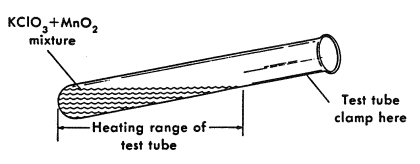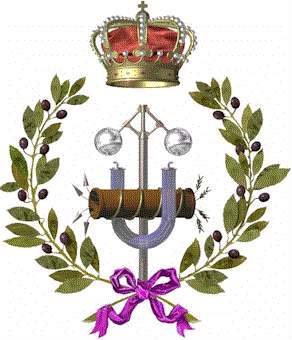NAME DATE PERIOD PERCENT COMPOSITION OF OXYGEN
COVERAGE PERIOD [SEE INSTRUCTIONS] S UMMARY OF0 21415 PERIODO OCHENTA Y SEIS DE
0 32737 PERIODO CIENTO CATORCE DE SESIONES
0 43752 PERIODO OCHENTA Y CINCO DE
0 43752 PERIODO OCHENTA Y CINCO DE
19 PERIODO CIENTO TRES DE SESIONES ORDINARIAS
|
NAME _______________________________ |
DATE______________ |
PERIOD _______ |
|
|
|
|
|
|
|
Percent Composition of Oxygen in KClO3 |
LAB 4 |
||
PRELAB INFORMATION
Percent composition is the percent by mass of each element in a compound. The percent composition includes as many percents as there are elements in the compound. To determine the theoretical percent composition, one compares the mass of each element present in a one mole sample of the compound. This can be written:
% element = mass element (g)
molar mass compound (g)
In this laboratory investigation, you will heat potassium chlorate with a catalyst. The result will be the decomposition of potassium chlorate into potassium chloride and oxygen gas as seen in the balanced chemical equation:
MnO2 (s)
 2KClO3(s)
2KCl(s) + 3O2(g)
2KClO3(s)
2KCl(s) + 3O2(g)
PURPOSE
The purpose of this lab is to experimentally determine the percent composition of oxygen in potassium chlorate and then compare your results to the theoretical value.
HYPOTHESIS – Calculate the theoretical % composition of O in KClO3 (use masses from the periodic table)
Calculation:
PROCEDURE
(follow written procedure; keep a record of the procedure in your lab book, but put it in your own words)
Mass an empty, clean dry test tube. Record.
Mass 1.00 g of potassium chlorate. Record. (Be sure to use weigh paper.)
Add the potassium chlorate to the test tube.
Mass 0.50 g of the catalyst manganese dioxide. Record.
Add the manganese dioxide to the potassium chlorate in the test tube.
Mix the two solids thoroughly by gently tapping the sides of the test tube.
U sing
a test tube holder, tip the test tube and its contents until it is
almost horizontal (70o).
Tap it gently until the contents are distributed evenly over the
lower wall of the test tube (see the figure).
sing
a test tube holder, tip the test tube and its contents until it is
almost horizontal (70o).
Tap it gently until the contents are distributed evenly over the
lower wall of the test tube (see the figure).
Holding the test tube at an angle and pointed away from others, move the test tube back and forth through the flame slowly and continuously, distributing the heat evenly over the entire length of the contents of the tube. Record your observations.
When no further changes to the matter are observed, approximately three minutes, stop heating and turn off the burner.
Let the test tube cool for approximately five minutes. Do not touch the bottom of the tube because the contents will remain hot for a longer time.
Mass the test tube and its contents. Record.
Place the waste as directed and clean up your workstation.
OBSERVATIONS/DATA
QUANTITATIVE DATA
|
Substance/Object |
Mass (______) |
|
Test tube |
|
|
KClO3 |
|
|
MnO2 |
|
|
Test tube + contents after heating |
|
QUALITATIVE DATA
|
Substance |
Observations |
|
KClO3 + MnO2 mixture before heating |
|
|
Contents of test tube during heating |
|
|
Contents of test tube after heating |
|
CALCULATIONS
Using your data, calculate the mass of KCl produced.
Calculate the mass of the oxygen produced by the reaction.
ANALYSIS/CONCLUSIONS
Calculate the percent of oxygen in your sample of potassium chlorate. Use data from the lab.
Calculate you percent error for the lab by comparing the actual percent of oxygen (hypothesis) to the experimental value (#3).
2 PERIODO CIENTO TREINTA Y CUATRO DE
2 PERIODO NOVENTA Y CUATRO DE SESIONES
2 PERIODO NOVENTA Y TRES DE SESIONES
Tags: composition of, % composition, period, composition, percent, oxygen
- LINGUA RUSSA I (LINGUA E FONOLOGIA)
- 1627 ANAIS DO 47º CONGRESSO BRASILEIRO DE CERÂMICA PROCEEDINGS
- NETWORK ASSISTANT SUMMARY ASSISTS WITH THE MAINTENANCE AND
- NUTRICIÓN MINERAL SI SE ELIMINA TODA EL AGUA DE
- WELCOME TO DENVER ARTHRITIS CLINIC! WE WOULD LIKE TO
- 41 EXP NO 15388 – 15993 – 16141 ACTOR
- FELICIDADES A TODAS NUESTRAS AMIGAS “CARMEN” NUESTRA SEÑORA DEL
- DIVISION OF LABOR AND INDUSTRY MARYLAND OCCUPATIONAL SAFETY AND
- PLACEMENT OFFER FORM 20212022 PERIOD FROM OCTOBER NOVEMBER TO
- [LLEGARON] POR EL CAMINO DOS FRAILES1 DE LA ORDEN
- MATHÉMATIQUES M9 DE L’ALBERTA PROGRAMME D’ÉTUDES AVEC LES INDICATEURS
- SOLRØD LÆRERFORENING KREDS 45 REFERAT AF KREDSSTYRELSESMØDE NR3
- UPOZORNĚNÍ ODBORU INFORMAČNÍCH TECHNOLOGIÍ K FYZICKÉ BEZPEČNOSTI PRO INFORMAČNÍ
- UNIVERSIDADE FEDERAL DO CEARÁ PRÓREITORIA DE EXTENSÃO COORDENADORIA DA
- TD LES MÉCANISMES DE MARCHÉ – L’EXEMPLE DU MARCHÉ
- SPECIFICATION FOR PRESSURE SENSOR NV LEVEL PRESSURE SENSOR FOR
- RSK – 6 PRIHODI OBJAŠNJENJA OBJAŠNJENJA KOJA SE
- ZAŁĄCZNIK DO UCHWAŁY NR 49518 ZARZĄDU WOJEWÓDZTWA MAZOWIECKIEGO Z
- POTĘGI I PIERWIASTKI CZY PAMIĘTASZ? PRAWA DZIAŁAŃ NA POTĘGACH
- ECETRANSWP1120096 PAGE 11 UNITED NATIONS E ECONOMIC AND SOCIAL
- Curriculum Vitae Hyekyeung Seung phd Cccslp Professor & Chair
- Concurso de Precios n° 6207 Expediente n° 0040101678722 Dirección
- ČESKÉ BUDĚJOVICE 10 3 2021 OPOMÍJENÁ PARAZITÁRNÍ NEMOC ZASAHUJE
- ZAŁĄCZNIK NR 3 DO REGULAMINU PRACY URZĘDU MIEJSKIEGO W
- FICHA DE ACTIVACIÓN DE CONVENIO DE EMERGENCIAS DATOS
- BUSINESS START UP GRANT APPLICATION FORM PLEASE COMPLETE THIS
- PROYECTO PRÁCTICO 1º OBSERVATORIOS SOCIALES FICHA PARA HACER UN
- NETWORK INTRUSION SIMULATION USING OPNET SHABANA RAZAK MIAN ZHOU
- LISA À PARIS – PIÈCE DE THÉÂTRE – UNITÉ
- D ONOJ PTY LTD TA BIG BARGAIN BOTTLESHOPS ABN
ZAŁĄCZNIK 2A DO SZOOP TABELA WSKAŹNIKÓW REZULTATU BEZPOŚREDNIEGO I
FE GOVERNANCE REVIEW CONSULTATION BUSINESS INDUSTRY AND ENTERPRISE
VIER SCHLÜSSEL WIE MAN GOTTES STIMME HÖRT UNSER ZEITALTER
 SOLICITUD ASISTENCIA MIEMBRO TRIBUNAL TESIS POR VIDEOCONFERENCIA DIRECTORA TESIS
SOLICITUD ASISTENCIA MIEMBRO TRIBUNAL TESIS POR VIDEOCONFERENCIA DIRECTORA TESIS A SI LO DESEA PUEDE RELLENAR ESTE FORMULARIO EN
A SI LO DESEA PUEDE RELLENAR ESTE FORMULARIO EN2 TARPININKAVIMO SUTARTIS NR PAR VILNIUS DU TŪKSTANČIAI
 OCTOBER 2019 PARK LANE TERRACE 295 GRAND RIVER STREET
OCTOBER 2019 PARK LANE TERRACE 295 GRAND RIVER STREETCONNECT 4 LOGO ALKUPERÄINEN CONNECT 4 PELI AGEPLAYER LOGO
 M UNICIPIO EL SALVADOR COORDINACIÓN ESTATAL DE PLANEACIÓN DIRECCIÓN
M UNICIPIO EL SALVADOR COORDINACIÓN ESTATAL DE PLANEACIÓN DIRECCIÓN NEWS RELEASE FOR RELEASE IMMEDIATELY DATE AUGUST 24 2007
NEWS RELEASE FOR RELEASE IMMEDIATELY DATE AUGUST 24 2007 QUIMICA II EXAMEN ORDINARIO DE LA ASIGNATURA 22
QUIMICA II EXAMEN ORDINARIO DE LA ASIGNATURA 22 ANIMATION IMPROVE HIGHWAY CODE RULES LEARNING IN DEAF CANDIDATES
ANIMATION IMPROVE HIGHWAY CODE RULES LEARNING IN DEAF CANDIDATESDIVISIÓN DE HONOR – 5ª JORNADA – 4 NOVIEMBRE
KEEPING CHILDREN SAFE IN EDUCATION – SEPTEMBER 2021 MULTIPLE
ANTE EL LEVANTAMIENTO DE LA SUSPENSIÓN DE LA LEY
 SCHOLARSHIP APPLICATION OSIECKI HONOURS SCHOLARSHIP FOR CLASSICS APPLICATION FORM
SCHOLARSHIP APPLICATION OSIECKI HONOURS SCHOLARSHIP FOR CLASSICS APPLICATION FORM PLIEGO DE CONDICIONES PARTICULARES MEDIANTE PROCEDIMIENTO NEGOCIADO QUE REGIRÁ
PLIEGO DE CONDICIONES PARTICULARES MEDIANTE PROCEDIMIENTO NEGOCIADO QUE REGIRÁMYNDIGHETEN FÖR SAMHÄLLSSKYDD OCH BEREDSKAP SID 3 (3) ANSLUTNING
SERVICIOS DE LAS ORGANIZACIONES ADSIS BESTALDE ASOCIACIÓN BIDESARI BILBO
 UNC ADULT ICED (INDUCED COOLING TO ELIMINATE DEFICITS) PROTOCOL
UNC ADULT ICED (INDUCED COOLING TO ELIMINATE DEFICITS) PROTOCOL